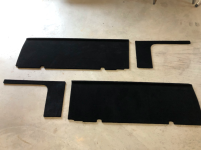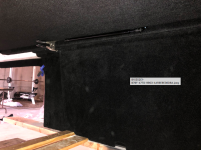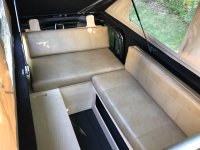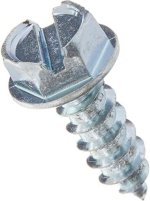I had coroplast for 2 years and finally removed it early this 2024. After a few summers and winters in Southern CA, it started to warp. Especially during summer, it bows out. I had it attached to the framing of the camper with velcro. No screws. I removed it all. It worked great and looked good when flat up against the walls with 1" foam underneath. But in the summer when it bowed out, it looked ugly to me. I took it out and used FRP wall paneling from Home Depot in white. Easy to clean, sturdy and a bit heavier but stays nice and straight and doesn't bow out. I used sheet metal screws to retain the walls, no VHB or velcro this time around. My ceiling is still Coroplast, it is bowed down looks like a ceiling that just underwent a rain storm and is about to collapse. It's held on with velcro only. And because they only sell coroplast in 4x8 sheets I had to use multiple sheets and the seams are hideous. OVRLND didn't have a headliner option back in 2021 when I bought my camper otherwise I'd have gone with that instead. I plan to remove the coroplast up there and run carpet tiles likely.
For screws I used something that looks like this:
View attachment 863636
That’s unfortunate, and a bit puzzling too. It’s a shame cause Coroplast is really durable and superlight weight. I have had my Ovrlnd interior finished with Coroplast sitting in the Phoenix heat for 3 years and have had no problem at all with warping or sagging. I personally wouldn’t give up on it as a lightweight covering with some cautions that I learned over time working with it. Off the top of my head I can think of a couple issues that could have caused @aaaslayer’s sagging/warping:
— I mounted mine with VHB, and even used some 1/4” wide Amazon knockoff VHB that has held up really well. I always prepped well with isopropyl alcohol, both before and after scuffing with 80 grit sandpaper. I also anchored some panels, not all, with self tapping lathe screws in the top corners. I didn’t use really big sheets (I bought two big ones and cut to fit on each frame section). I also mounted the sheets with the channels going vertically. When Coroplast is heated a lot (eg, I’ve used a heat gun to shape it) it will curve readily on the axis 90º to the channels. I think the support of the channels aligned vertically and the tight attachment with the scews and VHB around the whole perimeter may have kept mine flat. BTW, It’s not that hard to pull back off with the 1/4” knockoff VHB.
— I have had Velcro fail that I used to attached things to the Coroplast: a screen around my window hatch and a reflective/insulated cover to my rear window. In both cases the Velcro has failed in that it creeped and buckled, though it still stayed up. In both cases it creeped a good 3/4” leaving a sticky trail. I believe this is due to two things:
1) Heat and the fact that that sticky Velcro, even good 3M brand, doesn’t have as good adhesive as actual VHB, or apparently the knockoff stuff either since it hasn’t crept and wandered on me.
2) Coroplast is LDPE and like just about any plastic with heat and time will react with adhesives causing them to let go a bit. Heat makes it worse. 3M makes a so called low surface energy, white colored, VHB that can stick well to plastics and vinyls. You can also use the 3M primer before applying VHB and/or flame off the subsurface plasticizers. I have had great results using both techniques and regular VHB, depending on just how permanent I want the bond to be. Flaming is as easy as running a BIC lighter quickly across the surface a couple of times. I have treated NON-stick bulk velcro also with these techniques and usedreal VHB and it has held up.
Sometimes I wish I had used Velcro on some of my Coroplast panels for easier off and on, but if I do, I will use non-sticky velcro and use primer and flame treatment and real 3M
5259 Edit: 5952 VHB (dang, I always do that) to make it stick. Corner self tapping screws are a good idea and easy to remove and replace too. I agree that Coroplast is too heavy for a headliner to avoid sagging.
Hope this is helpful to others.





